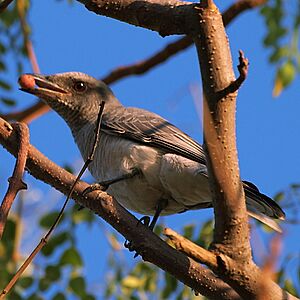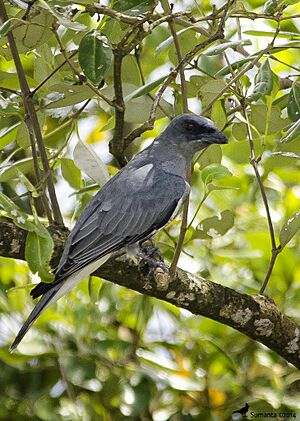Large cuckooshrike facts for kids
Quick facts for kids Large cuckooshrike |
|
|---|---|
 |
|
| Female (Gujarat) |
|
| Conservation status | |
| Scientific classification | |
| Genus: |
Coracina
|
| Species: |
macei
|
| Synonyms | |
|
Graucalus macei Lesson, 1831 |
|
The large cuckooshrike (Coracina macei) is a type of bird found in the Indian Subcontinent and parts of Southeast Asia. It's called a cuckooshrike because it belongs to a family of birds that look a bit like cuckoos and shrikes, but they are their own unique kind! Scientists sometimes call it the Indian cuckooshrike when talking about the birds found in India and Sri Lanka. There are many different kinds of these birds, and scientists are still working to figure out exactly how they are all related.
What Does It Look Like?
Adult male large cuckooshrikes have a wide, clear stripe around their eyes. Females have a paler eye stripe. The males have a grey throat and chest, and their belly and sides have fine stripes. Females also have stripes on their throat and chest, which go further down their body. They don't have the bright white belly that males do.
These birds mostly eat insects, but they also enjoy eating figs and other fruits from the forest. They usually fly in small groups, moving with a bouncy flight just above the tops of the trees. The cuckooshrikes in India make a loud call that sounds like klu-eep. When they land on a branch, they have a special habit of flicking their closed wings one after the other. They also use these wing movements when they are trying to find a mate.
Taxonomy and How They Are Related
Scientists recognize several different types, or subspecies, of the large cuckooshrike. However, there is still some confusion, and experts are working to fully understand how all these groups are related to each other. For example, some scientists consider the birds found in the Himalayas as a subspecies of a different cuckooshrike species. The way these birds are classified can change as scientists learn more about them.
Reproduction
Large cuckooshrikes build their nests during the dry winter months. Their nest is shaped like a shallow saucer and is usually placed high up in the fork of a horizontal tree branch. They build the nest using small twigs and grass, and they often decorate the outside with spider webs. The inside of the nest has very little soft lining. In India, they usually lay three eggs, but in areas around Bengal, they typically lay two eggs.



